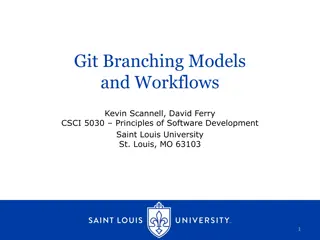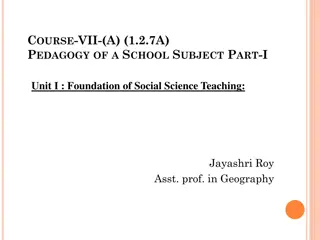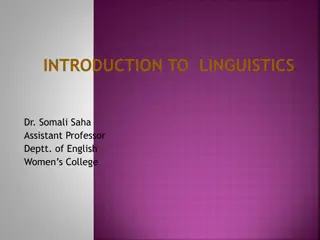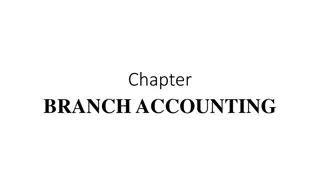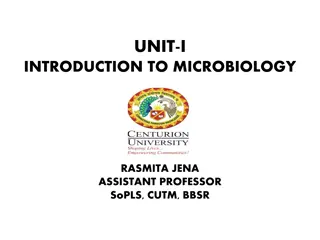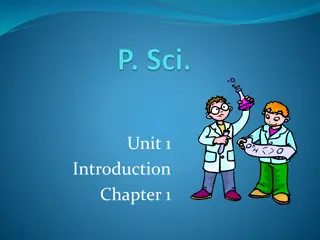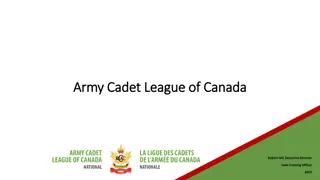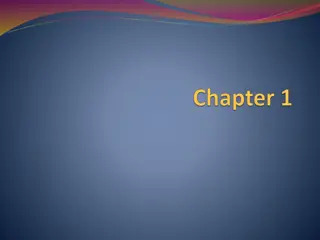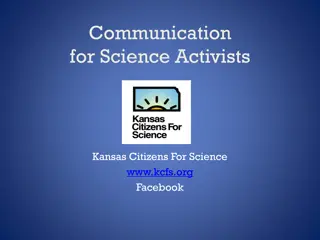Introduction to Science and its Branches
Science is the organized way of gathering and analyzing evidence about the natural world. It encompasses various branches such as Biology, Earth Science, Chemistry, and Physics, each focusing on different aspects of the world around us. Careers in these fields range from doctors and nurses in Biology to geologists and meteorologists in Earth Science, chemists and pharmacists in Chemistry, and research scientists in Physics. Attitudes in Science include curiosity, skepticism, open-mindedness, and creativity. Technology plays a crucial role in scientific advancements, leading to new inventions and impacting daily lives. Science is a dynamic field constantly tested and questioned.
Uploaded on Oct 08, 2024 | 0 Views
Download Presentation

Please find below an Image/Link to download the presentation.
The content on the website is provided AS IS for your information and personal use only. It may not be sold, licensed, or shared on other websites without obtaining consent from the author. Download presentation by click this link. If you encounter any issues during the download, it is possible that the publisher has removed the file from their server.
E N D
Presentation Transcript
What is Science? Chapter 1
Science: An organized way of gathering and analyzing evidence about the natural world
Branches of Science Biology Earth Science Chemistry Physics
Biology The study of life and living things Careers: doctor, marine biologist, nurse, geneticist, veterinarian, zoologist, surgeon, agriculturalist, bioengineer, botanist, pathologist
Earth Science The study of the planet earth and its neighboring space Careers: geologist, oceanographer, meteorologist, climatologist, environmental scientist, astronomer, astronaut
Chemistry The study of the composition, structure, properties and change of matter Careers: chemist, pharmacist, nurse, doctor, forensic scientists, chemical engineer
Physics the study of matter and its motion through space and time, along with related concepts such as energy and force Careers: research scientist, astrophysicist, cosmologist, electronics, nuclear physicist, quantum mechanists
And of course TEACHER!
Attitudes in Science Curiosity o Keep looking for more investigations Skepticism o Questioning existing ideas and hypotheses and refuse to accept explanations without evidence Open-Mindedness o Willing to accept different ideas Creativity o Think out of the box
Technology Lead to new inventions Gather data in new ways Big impact in peoples daily lives Mass produce items o Vitamins o Antibiotics o Hormones
Science is constantly being tested and questioned
Pose a Question The Scientific Method Make Observations and Inferences A set of steps scientists use to solve a problem or test an idea while studying the natural world Develop a Hypothesis Design an Experiment to Test a Hypothesis Make Measurements and Collect Data Interpret Data Draw Conclusions
STEP 1: Pose a Question http://t2.gstatic.com/images?q=tbn:ANd9GcT5XR_wrJXf0pMzZpzFFO2XGTZbxi6bkO0U-b2oXn7Sguk5xnIS The Scientific Method always starts with a question or a problem Example: Does fertilizer help plants grow?
STEP 2: Make Observations and Inferences Observations: using one or more of the senses to gather information and collect data Data: facts, figures and other evidences gathered through observation
Observation v. Inference Qualitative: descriptions based on some characteristic (color, shape, texture, etc. using your senses) Quantitative: measurable data, collection of numbers Inference: an interpretation of an observation or answer to a scientific question ***not a fact only an interpretation
STEP 3: Develop a Hypothesis Hypothesis: a possible explanation for a set of observations or answer to a scientific question *** must be testable ***must test is multiple times
Hypothesis Then statements The best hypotheses are If Example: If I add fertilizer to the plants, then the plants will grow taller. The If part of the statement describes the experiment The Then part of the hypothesis gives the possible outcomes
STEP 4: Design an Experiment The experiment is designed to test your hypothesis You can use your hypothesis to help you design the experiment Variables: factors that can change in an experiment
Types of Variables Manipulated Variable (Independent): - The part of the experiment we change - Ex. The amount of fertilizer given to plants Responding Variable (Dependent): - The part of the experiment that changes because of what we did - Ex. The height the plant grows
Controlled Experiment Only ONE variable is tested at a time Increases accuracy All other conditions are the same between the experimental group and the control group Control group: the group that is given no experimental condition
STEP 5:Carry out Experiment Use an instrument to MEASURE the manipulated variable Instruments include: ruler, balance scale, graduated cylinder, yard stick, stop watch, clock Measurements: weight, height, time, volume A measurement of the data you will collect International System of Units (SI): metric system Allows scientist from all countries to communicate
STEP 6: Collect & Interpret Data What does the information I collected mean? Arranging the results in an organized way Ex. Data tables, graphs Looking for patterns or trends Ex. The plants that received more fertilizer grew taller Find possible sources of error
STEP 7: Drawing Conclusions Summarizing what you learned in the experiment Deciding whether or not that data supports your original hypothesis The conclusion will either support a hypothesis or prove it wrong Even if you prove you hypothesis wrong, you will learn from the experiment
Scientific Theories Scientific Theory: a well-tested concept that explains a wide range of observations Allows scientists to make accurate predictions Not a fact Can be proven wrong by other experiments Theories are often revised and retested Example: Evolutionary Theory Theories can become the dominant opinion
Science and Society Ethics Morality Avoiding Bias





